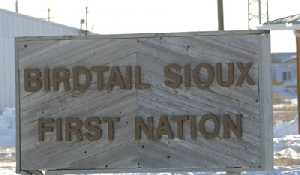Premier visits Moosomin to see flooding
July 15, 2014, 3:04 am
Julia Dima


Saskatchewan Premier Brad Wall was in Moosomin Monday—after the first of two major downpours hit the area and led to flooding.
Wall has been touring a number of communities in Southeast Saskatchewan that have been affected by the floodwaters that have led to destroyed homes, evacuations, and washed-out highways across the region. When the rainfall hit on the July long weekend, 200 mm of rain fell on Moosomin and the region in under 48 hours.
Just as people were well into recovery mode, another major downpour of several inches of rain in an hour led to more flooded basements and streets. Some basements were flooded for the second time in two weeks Thursday evening.
“If you think about the places that got hit hardest and fastest, first, Moosomin is ground zero,” Wall said during a meeting with Town and RM councillors in Moosomin on Monday.
The visit was two-pronged, consisting first of a meeting with the town and RM councils to discuss concerns and issues in the clean-up phase of the flooding, and secondly of a tour around the town and RM to see first hand what damage the flooding did.
Wall told the councils that one of the goals of the meeting is to address shortcomings and problems they may be seeing with the Provincial Disaster Assistance Program (PDAP). One of the big issues Wall has already been hearing about is timeliness.
“We know that we are at about 95 per cent claims closed from previous years. Last year, we had fewer claims, and are about 75 per cent closed there. The five per cent outstanding from the years previous to 2013 are mostly going to be disputes or infrastructure pieces that are still underwater or unable to assess—But there are some reasonable criticisms of the program in terms of timeliness,” Wall told the councils. “So what I would say is that we want to make sure that whatever we need to do to improve it, let’s do those things. We announced and confirmed PDAP offices to open up here in Moosomin and the area, so people can get answers for questions they have. A lot of the disputes, we think can be alleviated—or a lot of delays can be alleviated if people are taking pictures and keeping receipts and have an understanding about what is eligible and what is not.”
Wall heard concerns from the RM council about misunderstanding about eligibility through PDAP.
RM of Moosomin administrator Kendra Lawrence explained that about $40,000 of costs for the RM from the 2011 flooding were considered ineligible because the RM used their own equipment in some circumstances instead of equipment that was contracted out—she explained that in these situations, using the RM’s own equipment was a better use of resources and workers time. However, because the engineer’s report specified the RM to use contracted equipment, the costs were non-claimable. The RM is able to file an appeal to have these costs re-examined by PDAP, and will be doing so.
Wall said he is not sure why there is a discrepancy in coverage when RM equipment is used instead of contract equipment, but said he will look into this.
“We heard some good feedback from the RM about recognizing some of the challenges at the local level—for example, should there be a discrepancy between contracting out and having that refunded if you have to do some major work, versus using some municipal equipment, and we will be finding out the rational behind that,” Wall told the Spectator.
Wall asked about the impact of the flooding to citizens in the town, and town administrator Paul Listrom explained that of the 1,200 homes in Moosomin, about 600 had flooding to some degree. The town told Wall that the severity of flooding this year has topped 2011.
Another concern raised was drainage.
In Moosomin during the flooding, water flowed into the west side of town, covering Cook Road and Windover Avenue in about a foot of water, something Mayor Larry Tomlinson says he had never seen in years previous.
Wall presented a potential solution to addressing drainage issue that was proposed to him at his meeting with council in Wolseley on Monday morning, to use already flooded farmers fields as drainage areas rather than cutting land and draining water elsewhere.
“The idea I heard today was about using crop insurance—this wouldn’t be the long-term solution to drainage, but in the short term, if a person could buy stop loss related to flooding to hold the water, should we look at that? I think we should be looking at some specific initiatives that let the market provide a bit of an incentive for a farmer to say ‘I maybe can hold a bit of water, and I’ll be financially as good as I would be if I didn’t.’ I don’t know if this is a solution, I just think we need to start looking at different options,” Wall explained.
After the meeting, Wall toured a number of sites that were affected by the flooding, including a collapsed sewer main on Gordon Street, the areas of Cook Road that were engulfed by water, Wright Road, where the town built a berm to prevent further flooding into the homes on the street, the site of the new Celebration Ford dealership that dealt with flooding, and a section of grid road 600, north of Fleming, where there was a major wash-out.
Wall says the meetings and tours give him important insight in understanding how the handling of major disasters like the flood can be improved.
“Nothing replaces looking at the damage first hand that our RMs and towns are facing in the clean up—also the meetings with the councils are arguably as valuable as the first hand witnessing of the damage. because you hear right from the front line about challenges with PDAP that we need to address. We are now in the response phase of this, and to the extent that we can help make the response better, we need the input,” he says. His biggest takeaway from the RM and town of Moosomin is the eligibility concerns with PDAP.
“The RMs are working hard to make sure their claims are accurate, but they are also using their own common sense in terms what piece of equipment they might use to fix a problem—and PDAP should recognize that and not declare something ineligible just because it wasn’t part of the original plan to fix the problem. Is the problem fixed? Did the RM have to get it fixed? And if so, shouldn’t we be compensating that through the disaster assistance program?”



































